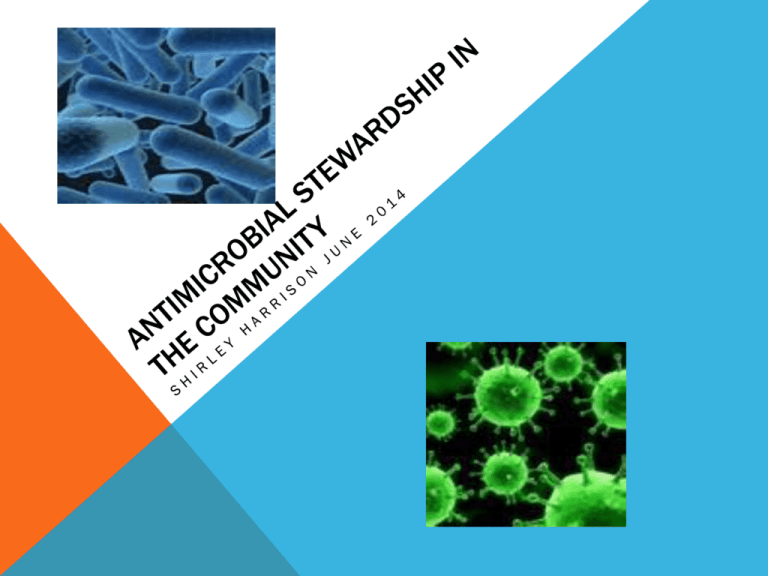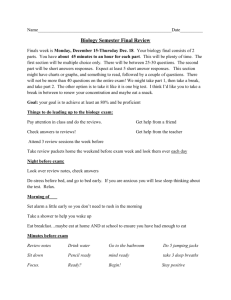Antimicrobial stewardship in the community
advertisement

ANTIMICROBIAL RESISTANCE The World Health Organisation (WHO) has identified antibiotic resistance as one of the three greatest threats to human health ANTIMICROBIAL RESISTANCE IN THE COMMUNITY The average consumer in the community is more familiar with the term antibiotic rather than antimicrobial. Estimating antibiotic usage in the community is a lot harder compared to hospital use. We can more accurately capture antibiotic prescriptions for concession and Repat patients but less so for general and full fee paying consumers as most are under the co-payment threshold. We then have to rely on estimates obtained from a representative sample of community pharmacies. ANTIBIOTIC USAGE IS IN THE COMMUNITY The National Prescribing Service embarked on a 5 year program to address antibiotic resistance with the roll-out of an educational NPS visit in 2012 on this topic. This proved to be a popular topic requested by many GPs throughout Australia including 4,500 GPs completing the clinical audit. The statistics relating to this antibiotic program are due to be released at the end of the year. However other health professionals such as pharmacists and nurses can influence antibiotic usage in the community through education and implementation of the principles of antibiotic stewardship. It is unfortunate that pharmacists and nurses were not offered the same educational visits as the GPs - due to a lack of funding. 742,000 people see a pharmacist , 300,000 see a GP a day McCrindle 2014 WHO ARE THE STAKEHOLDERS IN COMMUNITY HEALTH? Medicare Locals, community pharmacists, nurses ( ACFs, childcare centres, schools or community) and GPs. Medicare Locals: Bentley/Armadale, Fremantle, Goldfields-Midwest, Perth Central and East Metro, Perth North, Perth South Coastal and South West WA GPs are often concerned about pharmacists sending patients to them with patients being told they need an antibiotic. Yellow green phlegm does not mean bacterial - Not evidence-based information. Nurses: There is a growing number of nurses employed in the primary care setting. General Practitioners 2,454 (2011) WA 43,400 Aust (2011) ANTIMICROBIAL RESISTANCE You are twice as likely to carry resistant bacteria after a single course of antibiotics compared to someone who has not. The greatest risk is 30 days following antibiotic treatment and is likely to persist for up to 12 months. Costelloe C BMJ 2010 The longer the exposure to antibiotics, the greater the risk of acquiring and spreading resistant bacteria. Prof Chris Del Mar (Bond Uni) “antibiotic resistance decays with time with no antibiotic use”. NMS May 2014 The spread of antibiotic resistance is influenced by human migration, travel, agricultural practices and indiscriminate use of antibiotics. ANTIMICROBIAL STEWARDSHIP IN THE COMMUNITY Australian consumers often perceive ‘antibiotic’ resistance as the responsibility of hospitals, GPs and other prescribers – yet the greatest proportion of Ab usage is in the community The work of agencies such as the National Prescribing Service (NPS) and Consumer Medicine Information (CMI) is important in educating the community about antimicrobial resistance. Organisations such as the NPS and Medicare Locals (MLs) are suitable bodies to encompass the policies of antimicrobial stewardship. This would involve assistance with education for consumers or prescribers in primary care and the implementation of good antimicrobial practices within the framework of the current Antibiotic Therapeutic Guidelines 2010. ANTIMICROBIAL STEWARDSHIP IN THE COMMUNITY Which Medicare Local has an Antibiotic Stewardship Program in place? To be an accredited Medicare Local, there has to be in place some antibiotic/infection control policy. AMR STEWARDSHIP PROGRAM Unfortunately not a single Medicare Local has an Antimicrobial Stewardship Program in the community. Programs involving diabetes, COPD, pain management, CVD and mental health attract more funding AMR – WHAT DO WE NEED? A single regulatory body to co-ordinate use and distribution of antimicrobials in human and animal health and agriculture. We also need an organised approach to bridge that divide between hospital and community use of antimicrobials. AGAR CHALLENGES FOR GPS Under pressure to prescribe by consumers for various reasons There is no certainty in diagnosing infections Is it bacterial or is it viral? Is it bronchitis or pneumonia? Is it bronchiolitis or whooping cough? Fear of losing a patient to another surgery Fear of medico-legal problems PBS quantities? (trimethoprim) Repeats? Need software default to no repeats EDUCATIONAL PROGRAMS Community - child care centres, schools – Caring by Not Sharing! Responsible media reporting Allied health professionals – Aged Care Facilities and Nursing Homes GPs and prescribers – better communication with consumers – Time! Social media – Facebook (NPS), Twitter, Instagram Need a series of ‘ horror movies’ on Ab resistance ? CASE STUDY Jessica, a 24 year-old female presenting with a 4 day history of a sore throat, cough and a runny nose. She is attending a wedding over the weekend and is concerned that her symptoms will worsen. Medical and social history: NKA, non-smoker, lives with partner Physical examination by GP: slightly red throat, tonsils not inflamed and chest is clear, afebrile CASE STUDY THE ANTIBIOTIC CREED M Microbiology guides therapy when possible I Indications should be evidence-based N Narrowest spectrum required D Dosage appropriate to the type and site of infection M Minimise duration of therapy E Ensure monotherapy in most situations CASE STUDY Reasons for not prescribing: ⇨ probably viral and will resolve within 7 days ⇨ side effects of antibiotics e.g. thrush, nausea, vomiting, diarrhoea 50% of antibiotics prescribed in the community for URTIs are not indicated Antibiotic resistance – very few, delayed prescription CASE STUDY What if this is Jessica’s wedding?? AN ALTERNATIVE TO ANTIBIOTICS?? Prescription for: ADT one tablet tds 20 tablets ADT = Any damn thing! WHAT ARE PEOPLE SAYING IN THE COMMUNITY? Nurse (ML): The hospitals are to blame – it is all those IV antibiotics they are using GP (metro area): I saw two tourists within 3 weeks of each other, both with acute UTIs resistant to the antibiotics on the PBS – had to refer both to the hospital GP (suburb): What is the Health Dept policy on overseas visitors with communicable diseases? I had a patient with multi-resistant TB who arrived on the plane, possibly infected a whole lot of passengers around him and presented in my surgery. I sent him to the local hospital and they discharged him back to my care stating they cannot treat him. I rang the Health Dept and was more or less advised to send this person back home. Consumer: I have heard something in the news about antibiotics being not effective anymore. I only take antibiotics prescribed by my doctor. Consumer: I don’t take any antimicrobials, only an antibiotic sometimes LOCKING UP ANTIMICROBIALS AUTHORITY SCRIPTS/VALID FOR 2 WEEKS RE-VISITING IMPORTANT MEASURES Prevent infections/spread of infections : hand hygiene, cough etiquette, barriers to transmission (masks, isolation) lifestyle, overfed and under-nourished Minimise use of ‘problem’ antibiotics Immunisation : PCEMML story book on immunisation Symptom management (NPS) – what can be done to make the patient feel better Consumer education – embrace technology, 65% use a smartphone, antibiotic app BACK TO THE FUTURE OR THE PAST? Without effective antibiotics, routine procedures such as surgery, organ transplantation, chemotherapy, neonatology and intensive care will be We had to send ET home because we had no effective antibiotics to treat him! A BEAUTIFUL MIND We cannot eliminate antimicrobial resistance. It is always going to be there but we can put in place measures to delay the emergence, thus preserving the ‘miracle’ of antimicrobials for generations to come. WHO GLOBAL HEALTH THREATS Non-communicable diseases Global climate change Antibiotic Awareness Week: 2nd week November - activities in line with similar events globally Thank you very much for your attention!





